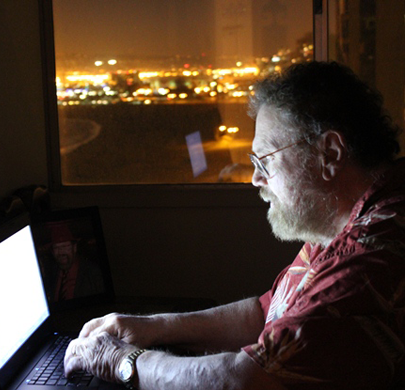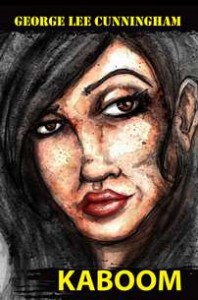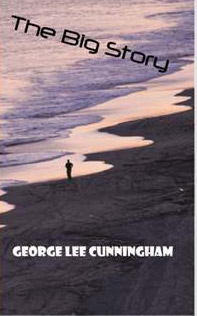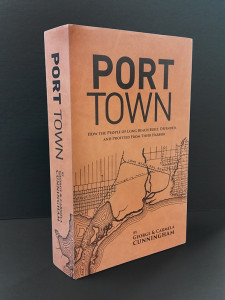ARCHIVED POSTS
-
May 1, 2019
GLAD TO GO AND GLAD TO BE BACK

HOME SWEET HOME
The United States is my home.
Every time I travel abroad, which admittedly has not been as often as I wish, I find myself missing my homeland. America is the greatest. Greater than Europe, greater than Asia or South America. Greater than Africa, Australia or Antarctica.
Admittedly, I’ve never been to Africa, Australia, or Antarctica, but I have heard nothing about those places that might change my mind.
My wife Carmela and I are back home from a Viking river cruise on one of those long boats you see floating along past hills and castles on all those Masterpiece Theater shows. You know the cool video clips that aren’t supposed to be ads, but really are.
Most people, even on our own ill-fated Viking voyage, are happy with their tour experience. But, this type of travel is not for everybody. Did we have a good time? Yes, we did. Would we do it again? Not on your life.
Here it is: The good, the bad, and the ugly.
Viking is a class cruise line. Everybody on their cruises has to be at least 18, which means no kids. The river cruises especially, are aimed at older passengers. We like children, especially the ones related to us, but there is a time to leave the kids at home. And that’s what Viking dictates their passengers do.

CRUISING DOWN THE RIVER
The Viking crewmembers are professionals in every sense. Friendly, patient, understanding, respectful, and diligent. They are well-trained, they come from around the globe, and they understand that their job is to keep their passengers happy, no matter what.
The food is good, but it is made to appeal to a wide spectrum of older travelers from all over the world, not all of whom have adventurous taste buds. They balance this out by having a range of choices, from a standard mixed salad, simple sirloin, and scoop of ice cream every night to local specialties, a special salad, and a choice of fancy desserts. Dress is business casual, which is vague enough to discourage jeans and tank tops, but not so rigid as to require passengers to put on coats and ties every night for dinner.
We had a cabin with our own balcony. There is nothing quite so idyllic as cruising up and down the river past farmhouses and small villages, where we could see life going on along the river bank. In some places there would be a highway or train tracks along the river with cars and trains whizzing past. In other places there were bike and hiking paths so close we would wave to the people on the path and they would wave back.
The river is also a highway for commerce, and we would pass live-aboard tug boats pushing barges full of all kinds of bulk goods up the Rhine and down the Danube. Observing life along the river as we slowly made our way upstream and down was a peaceful and easy way to spend a vacation.
One of the river boat’s best features is the top deck, which has comfortable chairs, a walking track, a putting green and a shuffle-board court. We spent a lot of time there, when it was open, and missed it when it was closed, which turned out, on our particular voyage, to be often.
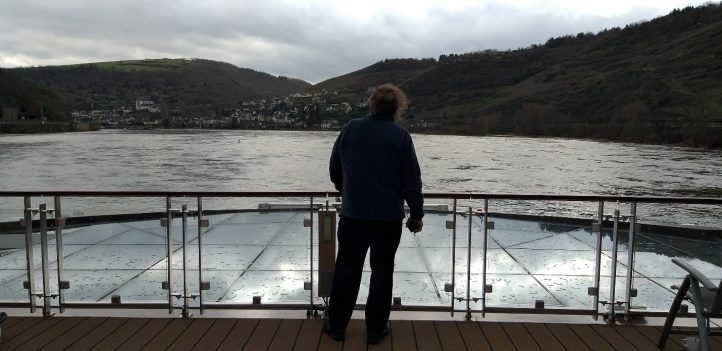
TOP DECK OF THE VILHALM -Photo by Carmela Cunningham
We began our trip with Viking’s three-day, pre-voyage option for Amsterdam. And although we loved Amsterdam, there were problems with Viking’s land package.
Amsterdam is a great city. It rained the entire time we were there, but we like rain and we were prepared for that. We walked all over the city, and we went to the Rijks and Van Gogh museums. We took streetcars and wandered around in the rain, and dodged the bicycle and motorbike traffic that was the main form of transportation for thousands of people.
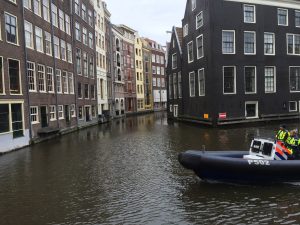
POLICE PATROLLING CANALS IN AMSTERDAM –Photo by George Cunningham
Amsterdam is bike-crazy. It is a flat city, with hardly any hills of which to speak. Thousands of bicycles line the streets. There are regular everyday bikes, bikes with big two-wheel box-seating in front for little kids to ride in, and bikes with trailers to carry small cargo. There were parked bikes lining every street and parking lots for bikes. How people can recognize their own bike from the jumble parked along the streets and canals is a mystery.
When it’s cold and it rains, which was every day we were there, people put on rain gear and rode their bikes in the rain and the cold. Coming from a country where people get in the car to go three blocks to the grocery store, it’s kind of cool to see folks pedaling under their own power. Part of the payoff? People seem to be slimmer, healthier, and more physically robust, than they do in America.
We took streetcars and wandered around in the rain, and dodged the bicycle and motorbike traffic that was the main form of transportation for thousands of people.
We had a great time in Amsterdam. But our visit was considerably shorter than the three days touted by Viking. We didn’t arrive there until after dark on Monday – jet-lagged and tired – and had to be onboard our boat at mid-afternoon on Wednesday. So although we were there on three separate days, our actual time in Amsterdam was less than 48 hours. Caveat Emptor. This one is on us. We knew what the deal was going in, but we chose to ignore it.
After our three lovely days in Amsterdam, we boarded our longboat and enjoyed cruising along the river in rain and sun, wearing our new three-in-one rain jackets, and enjoying the passing scenery.
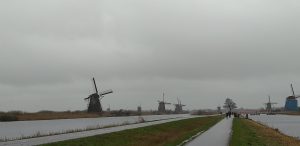
WINDMILLS OF KINDERDIJK –Photo by Carmela Cunningham
Until we came to a bridge too low. It was Viking’s first voyage of the year and the runoff from the mountains had raised the level of the river to such a height that our boat would literally not fit beneath the bridge.
So we pulled over to a berth by the bank alongside a gravel road in an industrial area outside of the German town of Wurzburg, and there we sat, waiting for the water to go down.
Normally, when the water is too high for boats to get under bridges or so low the boats are scrapping bottom, Viking moves the passengers by bus to switch places with people headed in the other direction on a different Viking boat. The boats then make U-turns and everybody continues their journey, up river or down. But we were the first cruise of the season – an added-in voyage that was earlier than Viking had sailed in years past – and there was no boat heading in the opposite direction, so we pulled over to the side, tied up, and waited for the water to go down. And there we waited for more than three days.
Viking tour buses came to the berth and transported people to the towns we would have visited on the boat, if the boat was not stuck behind a low bridge.
We went on the first bus trip – into downtown Wurzburg, a few miles upriver from where we were moored. It was about a 45-minute ride each way. Unfortunately, as the Viking Vilhalm sat at berth, the days passed and we passengers had to be transported farther and farther away from the boat to get to our excursion destinations. Longer bus rides meant that the time to see the castles and towns got shorter and shorter, until finally, Viking was putting people on a bus that drove three and a half hours in each direction for a one-hour visit at the destination. As time went by, many of the passengers – including Carmela and me – decided to pass on these trips.
It wasn’t just the long drives and short sight-seeing time that bored us. Most of these little German towns along the route were identical. There was the castle, the museum, the gift shops, and the tours led by a local guide that everybody followed around like a gaggle of sheep as he expounded on historical and artistic minutia.
While half the passengers were sitting on buses, the rest of us were back on the boat, where the crew did their best to make everybody comfortable. When we were finally able to slip under the bridge with just inches to spare, we proceeded onward, toward our final destination in Budapest.
We were still behind schedule, but trying to make up time.
With everybody stuck in such close quarters and the top open-air deck closed to passengers in order to slip under low bridges, and the chef ill – even though he bravely never left his post in the kitchen – passengers began to get sick.
Mostly it was just colds. People would retire to their cabins, then get bored, and finally come out coughing and sneezing to join everybody else as they tried to salvage their vacations. It wasn’t long before most of the passengers had some kind of ailment from a simple case of the sniffles to huge coughing fits.
There were scores of locks to go through along the canal that had been built across the mountains that separate the Rhine from the Danube, each one a stop along the way as pumps raised or lowered the water level and the ship for the next segment of the trip.
Viking kept the wine, beer and liquor flowing and baskets of free cookies on both the port and starboard sides of the boat, just outside the bar. It was a good strategy. Everyone was in too much of a sugar high or too tipsy on Irish Coffees and Margaritas to make trouble.
In the end, the big cities – at least what we saw of them – were the best part of the trip – Amsterdam, Vienna, Budapest, and the extra side-trip we took to Prague. Unfortunately, by the time we arrived in Vienna by bus for a truncated visit, we were both ill from being cooped up on a sick ship for days. We did manage get to a wonderful Mozart and Schubert concert in Vienna.
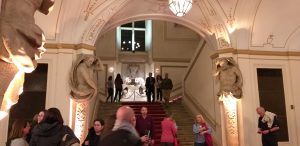
VIENNA CONCERT HALL — Photo by Carmela Cunningham
Carmela, who on the bus ride to the concert developed a severe case of chills and body aches, was told as we entered the theater that Austrian law forbids people from wearing coats inside a theater. Bureaucracy in action. They had no problem with my sports jacket.
Due to our time moored in Wurzburg, our time in Vienna had been reduced to less than 24 hours, so besides the concert, we saw a couple tourist shops and had to get back on the boat, bound for Budapest.
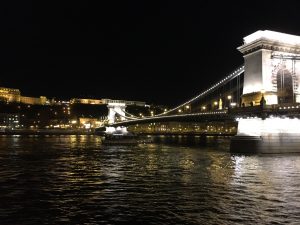
BUDAPEST AT NIGHT — Photo by George Cunningham
We were able to wander around Budapest and later Prague, but unfortunately by that time, we were so sick, we were only good for three or four hours at a time before having to return to the ship or hotel and collapse.
We visited five countries in Europe – The Netherlands, Germany, Austria, Hungary, and the Czech Republic.
Although we didn’t really spend enough time in any one country to really get to know the people, each country seemed to have its own personality. Much of the nonsense in Europe – such as limits on free speech and ownership of firearms – Americans would not put up with, but there are some things that are definitely better.
On the not-so-great side, which is probably more feeling than fact, people seemed more docile, especially in The Netherlands and Germany. The people we met seemed friendlier in Amsterdam than in the smaller towns along the Rhine, but that could have been merely the difference between big cities and small towns. We met some nice German folks – especially the ones that were trying to sell us something – but when we nodded and gave a smile to passing folks, they would often look away or just frown.
Maybe, they just don’t like tourists, or maybe they are merely shy.
People also seemed to use their inside voices more than we Americans do, even when they are outside. We were, of course, in Northern Europe. When we’ve visited Italy, for instance, people not only spoke up, they didn’t hesitate to express their pleasure or their disdain as the case may have been – and generally, as loudly as the situation warranted.
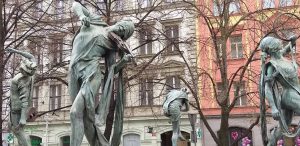
DOWNTOWN PRAGUE — Photo by Carmela Cunningham
The people in Budapest and Prague were somewhat different than those in Amsterdam, Vienna and the German towns. Both places had been occupied, first by the Nazis and then by the Communists. There continues to be a joy and a relief about being out from behind that curtain. The people were not only friendlier and happier than their German and Austrian counter-parts, they also seemed to be more independent and industrious as well.
They have taken the concrete box housing of the Communist years and painted it bright colors. And even though it’s impossible to hide the ugliness of the Communist architecture with a coat of paint, there is something joyous and life-affirming about the yellow and pink and green towering concrete rectangles that line the countryside.

A NEW COAT OF PAINT — Photo by Carmela Cunningham
Because we were still ailing by the time we got to the big cities, our trips about town were limited to a few hours at a time, but Budapest was beautiful and Prague was amazing –the architecture, the energy, and the people.
Our time was limited, and our health was impaired, but we enjoyed those cities, and we will go back. Next time on our own schedule and with our own agenda. If we end wandering around a grand city where we don’t know exactly where we are for a couple hours, and fewer guided tours – that’ll be fine by us.
Viking, as a way to compensate us for a trip gone wrong, has offered us a 30 percent discount on any future river cruise we might wish to book and shipboard credits. It’s tempting – they do make a nice Irish Coffee. But, we’re going to pass.
It wasn’t that we didn’t have a good time. We did. But at significant price – somewhere around $20,000 when you counted tips, laundry, and all the other extras. But that wasn’t the big problem. The big problem was having to move through the world on the Viking schedule. The company decided how long we stayed in each port, where we visited, and what we saw.
It is not a bad deal, but it’s just not us. On our own, we would have spent less money, stayed in less-than-five-star hotels, spent a lot more time in the big cities at concerts and museums, and skipped the cookie-cutter German towns along the way

PRAGUE WATERFRONT — Photo by Carmela Cunningham
We would have made our own decisions about where to visit and what to do when we got there. We probably would have laughed more at the misadventures that come with all travel. We would have had a lot better time, spending more of it just hanging out around town, meeting more of the locals, and plotting our own path.
I guess we’re just not “Viking people.”
When it was time to head home, which ended up being more than 20 hours of flying and lay-overs that started in Prague and ended in Los Angeles, it was an ordeal. And we were both still ailing. On the 12-and-a-half-hour last leg of the flight, I watched three full-length movies as we flew across Scotland, Greenland, Hudson Bay, Canada and the northern tier of the United States. I watched the movies, listened to music, and yearned to be back on American soil.
I have been away from home before, more than two years out of the country in the military, almost a year working construction in Puerto Rico, three weeks in Italy, and six weeks in Brazil and Uruguay. And every time I come back to my homeland, I feel the same elation.
For all its craziness. For all the fighting and political vitriol. For all its silliness – and even ugliness sometimes, America is my home. It’s where I belong. And it’s good to be back.
Do you have a dissenting opinion or any opinion at all on the subject? Contact me at george@georgeleecunningham.com and let me know. Meanwhile, you can always subscribe and get an email reminder of blog postings. Your name will not be shared and you may cancel at any time.
-
April 30, 2019
A WILD RIDE WITH AN ANGRY GERMAN

A WILD RIDE
One of the most exciting parts of our recent Viking river cruise along the Rhine and the Danube, was definitely not on the itinerary.
It was the day my wife, Carmela, and I took the bus to Wurzburg, skipped the guided tour of the Wurzburg Bishops’ Residenz (yet another of Germany’s largest and most ornate palaces), and spent our time wandering around town, mingling with the residents, which we enjoyed immensely. Unfortunately, when we got ready to go home, we found we had been given incorrect information from the guide, who inadvertently showed us the wrong place on the map to catch the bus back to the boat.
So as night began to fall, and rain began to pour, we missed our bus pick-up time and had to figure a way back to the boat.
We did the obvious thing. We called a cab, got a crazy and angry driver, who didn’t speak English, and who kept yelling at us, as though if he was just loud enough, we would suddenly be able to understand German.
Unfortunately, we didn’t really know exactly where the boat was moored. We called the boat, got an interpreter, and gave the phone to the driver. He yelled at her, and she yelled back. Meanwhile, we are sitting in the back seat, cold, wet, and hungry, thinking any minute we were going to be part of an international incident. Finally, the driver threw the phone to Carmela, started complaining loudly in German, and driving like a madman through the streets of Wurzburg, cursing other drivers, swerving through traffic, and waving his arms in all directions.
We didn’t have seatbelts to tighten, but we hung on for dear life. I’d like to say we were distraught, but in a way it was great fun. Were we going to die in some flaming crash? Maybe, but what an exciting way to go, speeding along the highways of Germany with a mad man at the wheel, yelling crazily at everybody he passed. It would certainly give our loved ones something to talk about for years to come.
Finally, after about an hour of this, the driver pulled into an industrial area of some German settlement, and motioned for us to get out. We didn’t really know where we were, or exactly where we should be going, but we did know that we were nowhere near a boat, and there was no river in sight. The driver didn’t seem bothered by this. He just kept yelling something, which we think was close to, “get the hell out of my cab!”
Carmela called the boat back, and gave the driver the phone. Another argument ensued. We could hear the person on the boat yelling at the driver and the driver screaming back at her.
Finally he threw the phone back at us, and sped off. At this point, Carmela started yelling at the driver and motioning for him to just let us out, but he ignored her. The people on the boat started yelling at Carmela to get his license number because they were going to call the police. Carmela, who is being thrown all around the back seat and yelling at both the cab driver and the people on the boat, was telling them it was impossible to get the license number because we were traveling at 50 mph down little two lane roads, and the driver wouldn’t stop.
Finally, the driver “flipped a u-ey,” as we say, turned down a gravel road parallel to the river, and delivered us to the boat, skidding to a stop and demanding 20 Euros. Meanwhile, about 10 of the boat crew were standing on the gangway waving their arms and yelling and looking ready to call the police when we showed up. We gave the driver his 20 Euros, plus a 5-Euro tip and got out of the cab.
The driver actually seemed touched at the gesture and nodded to us as he drove away. We went aboard and dressed for dinner.
Do you have a dissenting opinion or any opinion at all on the subject? Contact me at george@georgeleecunningham.com and let me know. Meanwhile, you can always subscribe and get an email reminder of blog postings. Your name will not be shared and you may cancel at any time.
-
March 8, 2019
LOVE AND MARRIAGE
For most of us, you meet someone, and you fall in love. You fill in the gaps and you smooth out the sharp edges between you and together you both become better people than you were on your own. But it’s not that simple for some folks. Some folks think about things so much, they become frozen in uncertainty, and they never take the chance on what could be heaven or what could be hell. READ MORE
-
SAVE THE BUGS
Our insect friends are rapidly disappearing. They may seem disgusting to us, but without them we’re in big trouble. We need bugs to help pollinate plants. Without bugs, there could be world-wide food shortages. And without bugs for food, the birds are in trouble too. Widespread use of pesticides is one problem. So is paving over much of urban areas and planting grass that replaces flowers and weeds. How can you help? READ MORE
-
The Long Road to Redemption
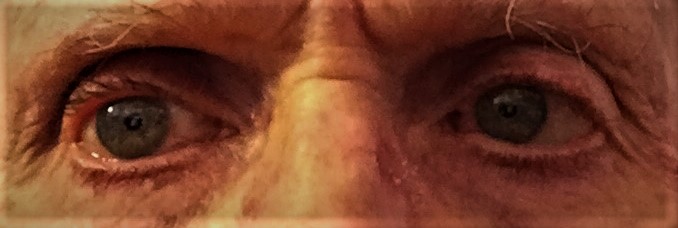
PUTTING THE PAST BEHIND YOU
It’s easy to be good if you’ve never been bad.
If you have never stepped over the line or done anything for which you are ashamed, you might not understand much about people who can’t make the same claim. If you’ve lived a good and honorable life, it’s easy to look down on those who have not done the same. It’s easy to condemn those who have cut corners and compromised their own – and society’s – ideas of right and wrong. The problem is, that once the “good people” make up their minds about the “bad people,” it’s difficult, if not impossible, for the “bad” ones to change.
The path to redemption is difficult. It’s a big challenge to change one’s own self-image and behavior, but often, the bigger challenge is changing the minds of other people. To begin, the person with a bad rep is faced with a choice – fight the odds to convince everyone that he has changed his ways – or just give in to the common wisdom that “people can’t change” and keep doing what got him into trouble in the first place.
Unfortunately, the second path is the one most often taken.
My wife Carmela worked with inmates at a prison near our home. In an age of welfare and health benefits, many openly and vocally planned to subject themselves to lives of poverty, rather than make the effort to find jobs or improve their lots. It’s just easier to give in, and many of the women said they’d prefer to have their time to do as they pleased with someone else paying their way, than to have to go to a job every day. Many thought that going to work every day was just too boring and too hard.
That’s a sad and frustrating reality for many people in prison. But for people who have done wrong, and who want to repent, what’s their path to respectability? How long should it take them to live down their pasts? Are they doomed forever, or is there a road to redemption that they can take without groveling, which never works. It only demeans the person begging for forgiveness.
The answer is that former felons should neither have to spend the rest of their lives begging forgiveness nor be forever haunted by their pasts. They have to acknowledge their misdeeds, find new people who have not yet made up their minds about them, and move on. But if their records follow them wherever they go, it becomes almost impossible to change. And, perhaps more importantly, if the friends and family they got into trouble with are still in their lives and still promoting the same harmful and illegal behavior, they need to give up those old friends and family members.
Real friends will understand that.
Do you have a dissenting opinion or any opinion at all on the subject? Contact me at george@georgeleecunningham.com and let me know. Meanwhile, you can always subscribe and get an email reminder of blog postings. Your name will not be shared and you may cancel at any time.

